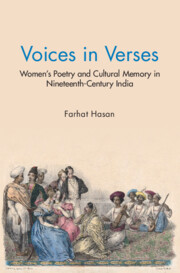Book contents
- Frontmatter
- Dedication
- Contents
- Acknowledgements
- A Note on Transliteration
- List of Abbreviations
- 1 Introduction
- 2 Unravelling the Texts: Memory, Reforms, and Literary Sulh-i-Kul
- 3 Representing an Inclusive Literary Culture: Women Poets in the Bazaars and Kothas
- 4 Representing the Kothas: The Two Sisters in the Literary Sphere
- 5 Commemorating Women Poets: Memory, Gender, and the Literary Culture in the Persianate World
- 6 Secluded Poets in Literary Spaces: Memorializing Female Rulers, Consorts, and Memsahibs
- 7 Conclusion
- Glossary
- Bibliography
- Index
3 - Representing an Inclusive Literary Culture: Women Poets in the Bazaars and Kothas
Published online by Cambridge University Press: 06 March 2024
- Frontmatter
- Dedication
- Contents
- Acknowledgements
- A Note on Transliteration
- List of Abbreviations
- 1 Introduction
- 2 Unravelling the Texts: Memory, Reforms, and Literary Sulh-i-Kul
- 3 Representing an Inclusive Literary Culture: Women Poets in the Bazaars and Kothas
- 4 Representing the Kothas: The Two Sisters in the Literary Sphere
- 5 Commemorating Women Poets: Memory, Gender, and the Literary Culture in the Persianate World
- 6 Secluded Poets in Literary Spaces: Memorializing Female Rulers, Consorts, and Memsahibs
- 7 Conclusion
- Glossary
- Bibliography
- Index
Summary
Studying the women poets in BN and TN, the reader is quickly confronted with two important components in the narrative structure. The first is the biographical prelude that precedes their literary compositions; in both the tazkiras, there is a clipping from their life stories that sets the context for delving into their poems. This is a standard writing technique in poetic tazkiras, but it is not without some significance here; one of its objectives is to guide the reader into the poet's work. It is as if a woman poet's life story or clippings therefrom provide the framework for the appreciation of her work. There is a thick enmeshment of the art with the person, and the life (and the body) of a poet with her poetic compositions. The second important element of the narrative structure is an overwhelming, but still permeable, distinction between ‘the secluded women’ (pardah nashīn) and ‘the public women’ (bāzāri ‘aurat); interestingly, the latter are further divided by the fluid and often overlapping categories of the courtesan (tawāi’f), the prostitute (randī), the slave girl (kanīz), the skilled dancer-cum-harlot (khāngī), the lower caste prostitute (kanchanī), and professional entertainers (domnīs).
‘Women of the Bazaar’: Internal Hierarchies and the Representation of Difference
There were many more distinctions that divided the bāzārī women, but the shifting boundaries among them always made it difficult to define any of these categories with any sense of precision. In an interesting interlude, Nadir informs us that the kanchanīs were called kanjars in Punjab, and in some places in Hindustan, they were also called the ‘children of Lord Ram’ or rām-janiyān. At several other places, he says, they were called pātar, gāyinān, and abchar; while they all came from lower caste groups, the distinctions in nomenclature referred not only to the regional specificities but also their sub-caste affiliations. In his ethno-historical aside on ‘public women’, he points out that owing to the lower social status of the kanchanīs, the khāngīs refrained from associating with them, even as they were both engaged in prostitution. He further informs us that the khāngī community was a close-knit group, with strict rules of inclusion.
- Type
- Chapter
- Information
- Voices in VersesWomen's Poetry and Cultural Memory in Nineteenth-Century India, pp. 55 - 90Publisher: Cambridge University PressPrint publication year: 2024

